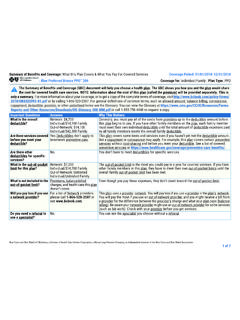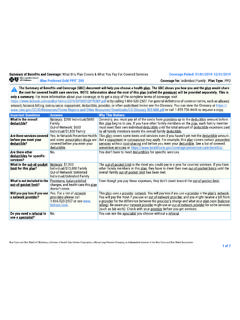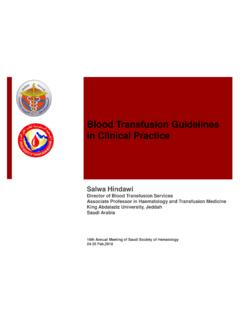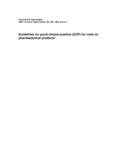Transcription of 2018 Clinical Practice Guideline - Health Insurance Oklahoma
1 2018 Clinical Practice Guideline Page 1 of 5 Cardiovascular Disease guidelines Purpose/Objectives Many major studies conclude that the incidence and progression of atherosclerotic cardiovasculardisease decreases when individuals address modifiable risks, including cigarette smoking,hypertension, high serum cholesterol physical inactivity, obesity and diabetes mellitus. Thisguideline focuses on risk factor modification, and incorporates consensus statements from theAmerican Heart Association (AHA), the American College of Cardiology (ACC) and/or theAmerican College of Cardiology Foundation (ACCF). (See References) This Guideline is designed to assist clinicians by providing a framework for evaluation andtreatment of patients and is not intended to either replace a clinician s judgment or establish aprotocol for all patients with a particular condition.
2 The final decision regarding medicaltreatment is made by the physician and the Abbreviation Table on page four. Primary Prevention It is reasonable to assess traditional atherosclerotic cardiovascular disease (ASCVD) risk factors every 4-6 years in adults 20-79 years of age who are free from ASCVD and estimate 10-year ASCVD risk every 4-6 years in adults 40-79 who are free from ASCVD. Traditional risk factors are age, sex, total and HDL-cholesterol, systolic blood pressure, use of antihypertensive therapy, diabetes, and current smoking status. For adults who would benefit from blood pressure lowering and/or LDL lowering, the American Heart Association recommends dietary patterns (such as the DASH dietary pattern, the USDA Food Pattern, or the AHA diet) and exercise. Additional details and recommendations for cholesterol management, management of overweight and obesity, management of other risk factors, and use of antiplatelet agents for primary prevention are summarized in the referenced documents.
3 Primary Prevention of Atherosclerotic Cardiovascular Disease Screening Recommendations Clinical Considerations Management/Control Source Guideline / Reference Page Assess at every visit Smoking status Offer cessation counselingwhen applicable Encourage avoidance ofsecond-hand orenvironmental smoke2/Page 389 Table 1 and Page 390 Table 2 Dietary intake of high-fat and/or high-calorie foods Encourage a healthy dietwhich includes vegetables,fruits, lean meats, low-fatoptions, whole grains, andlegumesNo more than moderate alcohol consumption 2/Page 389 Table 1 and Page 390 Table 2 Activity level Encourage physical activity, which is recommended at no less than five days per week for thirty minutes each day. 2/Page 389 Table 1 and Page 390 Table 2 2017 - 2018 Clinical Practice Guideline Page 2 of 5 Primary Prevention of Atherosclerotic Cardiovascular Disease (continued) Screening Recommendations Clinical Considerations Management/Control Source Guideline / Reference Page Recommend measuring and recording values no less than once every two years Blood pressure (BP) Goal < 140/90 mm Hg for up to age 80 Goal < 150/90 mm Hg for80 years or older Encourage a healthy lifestyle Initiate drug therapy whennecessary7/Page 1 Body mass index (BMI) Goal BMI optimal weight 2/Page 389 Table 1 and Page 390 Table 2 Pulse Documentation 2/Page 389 Table 1 and Page 390 Table 2 For adults age 20 79 who do not have cardiovascular disease, evaluate risk factors every 4 6 years.
4 For adultsage 40 79, use this information to assess for 10-year cardiovascular disease risk. Age Gender Total cholesterol High densitylipoproteincholesterol Systolic bloodpressure Use ofantihypertensivedrugs Diabetes mellitus Current smokingstatus Adherence to a heart healthydiet Regular exercise Avoidance of tobaccoproducts Achieving & maintaining anoptimal weight4/Page 10 Table 4 and 6/Page 13 Section In the absence of risk factors, testing for diabetes should begin for all individuals who are overweight or obese. Repeat testing at least as every 3 years. Consider more frequent testing given initial results. Screen for and manage diabetes In those with diabetes, optimal control is desired. See American Diabetes Association, Standards of Medical Care in Diabetes 2016. 9/ Clinical Considerations Secondary Prevention Important evidence from Clinical trials supports and broadens the merits of intensive risk-reduction therapies for patients with established coronary and other atherosclerotic vascular disease, including peripheral artery disease, atherosclerotic aortic disease, and carotid artery disease.
5 2017 - 2018 Clinical Practice Guideline Page 3 of 5 For adults who would benefit from blood pressure lowering and/or LDL lowering, the American Heart Association recommends dietary patterns (such as the DASH dietary pattern, the USDA Food Pattern, or the AHA diet) and exercise. Additional details about management of overweight and obesity, lifestyle management and recommendations for cholesterol management are summarized in the referenced documents. Recommended interventions regarding smoking, blood pressure control, Type 2 diabetes mellitus management, antiplatelet agents/ anticoagulants, renin-angiotensin-aldosterone system blockers and beta blockers, influenza vaccination, depression and cardiac rehabilitation are summarized in Table 1 in the AHA/ACCF secondary prevention and risk reduction therapy Guideline referenced above.
6 Suggested Preventive Measures and Reduction of Risk for Patients Diagnosed with Atherosclerotic Vascular Disease Intervention Source Guideline / Reference Page Assess smoking status at every visit and offer cessation counseling when applicable 1/Page 2459 Table 1 Recommendations for BP Goals Goal < 140/90 mm Hg for patients with HTN or CAD. Goal 130/80 mm Hg may be considered for patients with ahistory of MI, CAD, CVA or TIA, or for patients with carotidartery disease, PAD, or AAA, which are considered to be riskequivalents for CAD. For people over 80 years of age randomized controlled trials havenot conclusively demonstrated a target optimal blood 1382 - 1386 Initiate or continue high-intensity statin therapy as first-line therapy in those 75 years of age who have CVD, unless it is contraindicated.
7 If contraindicated, initiate moderate-intensity statin therapy if tolerated. Evaluate the benefits of risk-reduction, adverse side effects, drug-to-drug interactions, and consider patient preferences when initiating moderate or high-intensity statin therapy. Continue statin therapy in those with CVD if tolerated. 6/Page 22 Table 4 Assess how frequently the patient engages in physical activity and recommend no less than five days per week for thirty minutes each day when indicated 1/Page 2460 Table 1 Recommend and administer an annual influenza vaccine unless contraindicated 1/Page 2462 Table 1 Screen for depression when Clinical staff are available to assist the primary care clinician by providing direct depression care and/or coordination, case management, or mental Health treatment.
8 8/Current Recommendation Recommend low dose aspirin for daily usage in all patients with coronary artery disease unless contraindicated. 1/Page 2460 table 1 Recommend initial treatment with ACE inhibitors for indefinite usage in those with left ventricular ejection fraction of 40%, hypertension, diabetes, or chronic kidney disease, unless contraindicated. Consider ACE inhibitors post MI. 1/Page 2461 Table 1 10/Page 1380-1381 For those unable to tolerate ACE inhibitors as initial treatment, recommend ARBs in those with heart failure or who have had a myocardial infarction with left ventricular ejection fraction 40%. 1/Page 2461 Table 1 2017 - 2018 Clinical Practice Guideline Page 4 of 5 Suggested Preventive Measures and Reduction of Risk for Patients Diagnosed with Atherosclerotic Vascular Disease (continued) Intervention Source Guideline / Reference Page Recommend aldosterone blockade in conjunction with ACE inhibitors and Beta Blockers for those post-myocardial infarction who do not have significant renal impairment or hyperkalemia and who have a left ventricular ejection fraction 40% and who have diabetes or heart failure.
9 1/Page 2461 Table 1 For all patients with left ventricular systolic dysfunction who had angina, a previous myocardial infarction and/or have heart failure, recommend beta blockers unless contraindicated. 1/Page 2462 Table 1 10/Page 1380 Consider cardiac rehab for select patients with acute coronary syndrome 1/Page 2462 Table 1 Abbreviation Table AAA abdominal aortic aneurysm CVA cardiovascular accident ACC American College of Cardiology CVD cardiovascular disease ACCF American College of Cardiology Foundation DASH dietary approaches to stop hypertension ACE angiotensin converting enzyme HDL high density lipoprotein AHA American Heart Association HTN hypertension ARB angiotensin receptor blocker LDL low density lipoprotein ASCVD atherosclerotic cardiovascular disease MI myocardial infarction BP blood pressure PAD peripheral artery disease BMI body mass index TIA transient ischemic attack CAD coronary artery disease USDA United States Department of Agriculture AAA abdominal aortic aneurysm
10 CVA cardiovascular accident Cardiovascular Disease Source guidelines SC Jr, Benjamin EJ, Bonow RO, Braun LT, Creager MA, Franklin BA, Gibbons RJ, GrundySM, Hiratzka LF, Jones DW, Lloyd-Jones DM, Minissian M, Mosca L, Peterson ED, Sacco RL,Spertus J, Stein JH, Taubert KA. AHA/ACCF secondary prevention and risk reduction therapy forpatients with coronary and other atherosclerotic vascular disease: 2011 update: a Guideline from theAmerican Heart Association and American College of Cardiology Foundation. ;124:2458 2473. Available at: + A. Pearson, Steven N. Blair, Stephen R. Daniels, Robert H. Eckel, Joan M. Fair, Stephen , Barry A. Franklin, Larry B. Goldstein, Philip Greenland, Scott M. Grundy, YulingHong, Nancy Houston Miller, Ronald M. Lauer, Ira S. Ockene, Ralph L. Sacco, James F. Sallis,Jr, Sidney C.


















